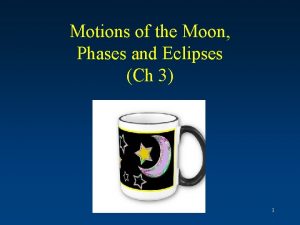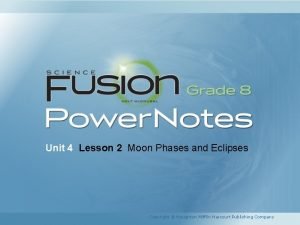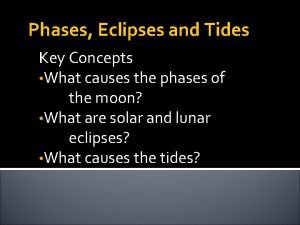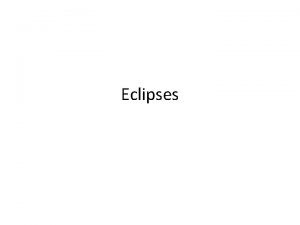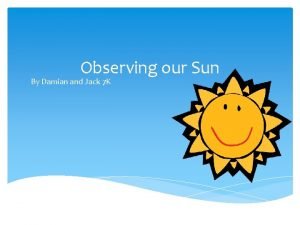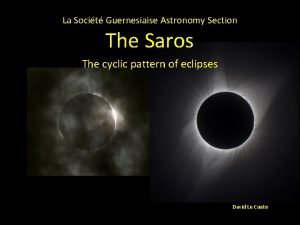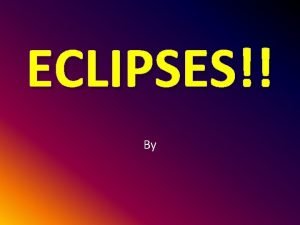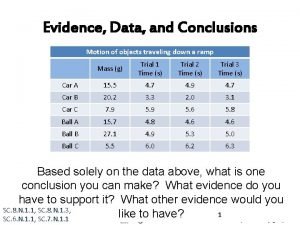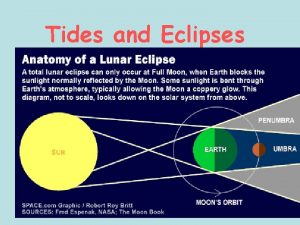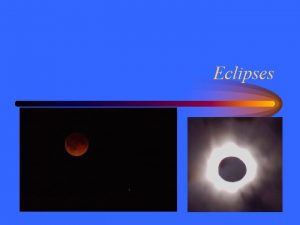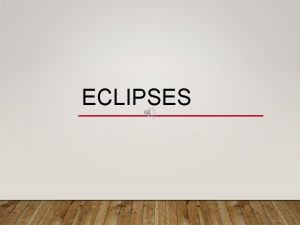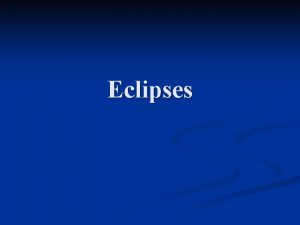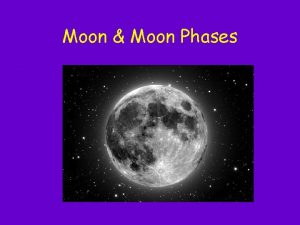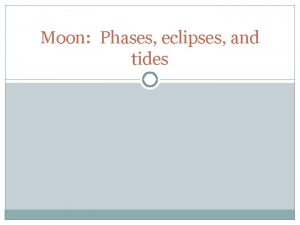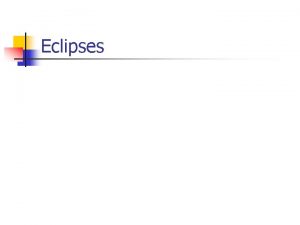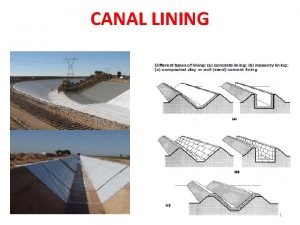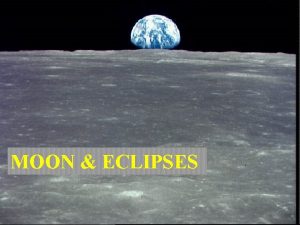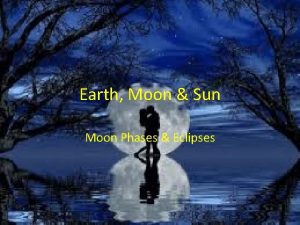Eclipses Lining Up At new moon the moon















- Slides: 15

Eclipses

Lining Up • At new moon the moon can block the sun. • At full moon the earth can block the sun to the moon. • This is called an eclipse. – Solar eclipse, lunar eclipse

Kinds of Eclipses v Solar Eclipse • Lunar Eclipse – Moon’s shadow on Earth – Occurs at a new moon – Earth’s shadow on moon – Occurs at a full moon Partial - crescent Sun Total - all of Sun is blocked Annular - a ring of the Sun Partial - moon partially dark Total - moon is dark red or copper-colored Earths atmosphere passes some light.

Orbital Inclination • The Moon has an orbit tilted at 5. 2° compared to the orbit of the Earth around the Sun. • When the Moon crosses the Sun-Earth plane, it is at a node. • The period between two ascending nodes is 27. 21 days – This is the draconic month.

Eclipse Seasons • Conditions for a solar eclipse: – New Moon (once every 29. 5 days) – Moon at a node (twice every 27. 2 days) • The circumstances happen about every 6 months. – May 10, 1994: Annular eclipse in N. America – Nov 3, 1994: Total eclipse in S. America

Season Duration • An eclipse season lasts about a month. – Full moon for lunar eclipse – New moon for solar eclipse Oct 8, 2014: Total Lunar eclipse Oct 23, 2014: Partial solar eclipse

Viewing Eclipses • Never look directly at the sun, even at a partial eclipse. • It’s ok to look at lunar and true total eclipses. • View sun through #14 welder’s glass or special mylar filters.

Total Solar Eclipse • August 11, 1999: Szombately, Hungary Photographs by Michael Fortner

Total Lunar Eclipse • April 15, 2014: West Chicago, Illinois Photograph by Michael Fortner

Lunar Orbit • The Moon has a synodic period of 29. 53 days. – the time from new moon to new moon. • The Moon’s orbit is an ellipse. – At the nearest, perigee, the distance is 363, 000 km – At the farthest, apogee, the distance is 406, 000 km • The period between perigees is 27. 55 days. – This is the anomalistic period.

Try It! • Close one eye. • Hold a coin out far enough to completely block the circle. • Move out a little for an annular eclipse.

Annular Eclipse • May 10, 1994, North Central United States Photograph by John Chumack

Saros Cycle • Convergence of cycles – 223 synodic months is 6585. 3 days – So is 242 draconic months, and 239 anomalistic months • Every 18 years, 11 days, and 8 hours the Earth, Moon and Sun are in the same position. • These cycles were known since antiquity, and used to predict eclipses.

Track of Totality • Great American Eclipse of 2017 – Same saros cycle as 1999 Photographs by Michael Fortner

Upcoming Eclipse • If you missed 2017, next total eclipse in North America is April 8, 2024
 Lunar eclipse moon phase
Lunar eclipse moon phase Lesson 2 moon phases and eclipses answer key
Lesson 2 moon phases and eclipses answer key Which best explains why the moon has phases
Which best explains why the moon has phases Which moon phase occurs directly before a new moon
Which moon phase occurs directly before a new moon Which moon phase occurs directly before a new moon
Which moon phase occurs directly before a new moon What causes eclipses
What causes eclipses Brainpop solar eclipse
Brainpop solar eclipse The two eclipses
The two eclipses Why is the sun so important
Why is the sun so important Eclipses and tides lesson 3
Eclipses and tides lesson 3 The sun-earth-moon system worksheet answers lesson 1
The sun-earth-moon system worksheet answers lesson 1 The two eclipses
The two eclipses Que es una onda
Que es una onda Ano ang pagkakaiba ng solar at lunar eclipse
Ano ang pagkakaiba ng solar at lunar eclipse Conclusion
Conclusion What type of tide occurs at a lunar and solar eclipse?
What type of tide occurs at a lunar and solar eclipse?
